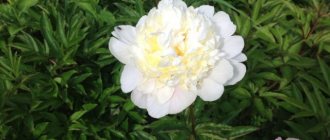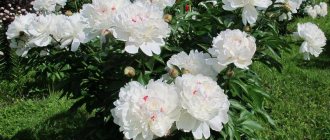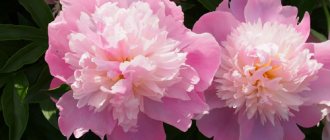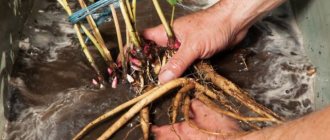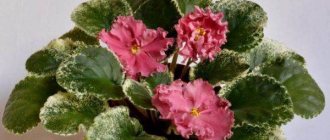Description
The Red Charm peony is a herbaceous plant; it can reach a height of 100 centimeters. Its flowering period is from May to early June. The flowers are large, up to 20 centimeters in diameter. Peony has a complex structure: more than 15 soft petals are concave into the outer dense bud.
The leaves are openwork, they are colored dark green, closer to autumn they become reddish and look original. "Red Charm" has strong foliage and peduncles, which contributes to the lowering of the large bud downwards. Flowers bloom early, the flowering period of this variety is long. In one area, the plant can exist for about 15 years.
This variety is frost-resistant and tolerates drought well.
Main features of the Red Charm variety:
- light aroma;
- attractive appearance when cut;
- the correct concavity of the petals contributes to the formation of a lush red inflorescence;
- the inflorescence is characterized by splendor, bomb-shaped, terry;
- The thickness and strength of the stem does not eliminate the need for tying.
Varieties
Thanks to the successful and painstaking work of many breeders, a large number of varieties of this plant have been developed.
"Coral Pink"
This beautiful plant reaches 75 centimeters in height, has soft green carved leaves, as well as double flowers of a light pink hue. When opened, the bud reaches 13 centimeters in circumference.
Flowering begins in June and lasts about 3 weeks. This variety is very popular among gardeners due to its beauty and compactness.
"Pink Hawaiian Coral"
This variety of peonies was bred in the 90s of the last century by American scientists. It is a perennial herbaceous plant that grows up to one meter in height. At the same time, its stems are quite dense and dotted with green carved foliage.
The flowers are semi-double and large, up to 21 centimeters in diameter, with an apricot tint. Very often they are used for cutting.
Flowering begins early - in April, and lasts up to 3 weeks (maybe longer in cool weather).
"Coral Beach"
Peony is distinguished not only by its beautiful and lush bush up to one meter in height, but also by its delicate coral color. The flower itself is small, up to 15 centimeters in diameter. The inflorescences are semi-double, with a yellow center. In their shape, the open buds are somewhat reminiscent of lotus flowers.
A distinctive feature of peonies of this variety is their resistance to various temperature changes, as well as to some fungal diseases. Thanks to this, it is very popular among many summer residents.
"Fairy Coral"
This variety of peonies is an interspecific hybrid. Its appearance dates back to the last century. The bush is low, up to 70 centimeters, the stems are dense with beautiful decorative leaves.
Coral semi-double buds, when opened, reach up to 15 centimeters in diameter and emit a delicate aroma.
"Coral Sunset"
A very popular variety of peonies. It is compact, but the height of the plant reaches in some cases up to one meter.
Semi-double buds are located on tall, erect stems, which are pink-peach in color with a hint of red coral. The leaves are green in color. Flowering begins early.
"Coral Sunset" has received many awards at various exhibitions not only due to its beauty, but also for its easy care and resistance to temperature changes.
"Coral Magic"
This newly developed peony variety has wowed everyone with its colorful flowers. These are semi-double three-row buds with a very bright color that are visible from afar.
They reach up to 15 centimeters in circumference and have yellow stamens in the middle. The bush is compact and low, up to 70 centimeters. The stems are erect with delicate green foliage. Flowering begins in April.
"Coral Supreme"
This hybrid plant is very rare. The bush has powerful stems that grow up to one meter in height. Its carved bright green leaves cover almost the entire bush, only the coral-salmon buds located at its very top are visible.
When they open, they look like a bowl reaching up to 19 centimeters in diameter. In addition, during flowering they emit a very subtle aroma.
"Coral and Gold"
This peony variety amazes everyone with its unusual beauty and large flowers. Already at the end of March or beginning of April, you can see double coral buds on the tops of a huge bush, up to 95 centimeters tall.
When they bloom, they can be up to 21 centimeters in diameter. In addition, the flowers exude a rich, sweet aroma. The stems are decorated with green carved leaves.
"Topeka Coral"
Peonies of this variety are distinguished by double bomb-shaped buds. At the beginning of flowering, their color is pink-red, but as they open, the flowers become coral.
The Topeka Coral bush does not grow higher than 65 centimeters. The leaves are carved with a dark green color.
"Coral Charm"
This variety of semi-double peonies is very popular among gardeners, so it is most often purchased for planting in personal plots. Its color is very unusual: a dark pink flower, which as it blooms becomes coral with a delicate white border.
At the very end of flowering it turns yellow. The bud itself is large, up to 22 centimeters in size, and consists of eight rows of petals.
The stems are straight and strong, with a reddish color. Peony leaves are green and carved. The height of the bush reaches a meter in height. Flowering begins in early June.
Landing
The cultivation of the Red Charm variety should be carried out by dividing the root system. It is best to use a representative who is 4–5 years old for this purpose. Transplantation should be carried out 2–3 weeks after the end of the flowering phase. The best time for this work is considered to be the end of August - the first week of September.
Before replanting, the peony flower should be watered abundantly, after which the bush is dug up, shaken off the existing soil and divided. Each division should have a neck section, 4–5 buds, and several roots. The planting material is inspected, spoiled, clay and damaged roots are eliminated.
If a plant is infected by a parasite, the roots should be kept in a manganese solution, and then replanting should begin.
The landing procedure is characterized by a number of important points and must be carried out strictly step by step.
- The dimensions of the hole should be slightly larger than the size of the division (so that the root system does not touch the walls of the hole). The distance between peonies should be at least 0.6 meters.
- Rotted manure or compost should be placed at the bottom of the pit and mixed with soil. Then you need to put pebbles on the mixture, on top of which the substrate and the plant.
- The flower should be immersed no more than 5 centimeters.
- The peony needs to be sprinkled with soil and fertilizer.
- At the end of planting, the soil is trampled down and mulched with peat.
- The transplanted peony should be watered abundantly throughout the summer.
Growing and care
The Red Charm peony is an early plant, but it is grown in much the same way as other varieties. Features of breeding this plant:
- red peony is quite vulnerable to fungal diseases, so when planting it is worth choosing an area that is well ventilated;
- It is also worth choosing a place that is well lit and has drained soil with compost;
- if the substrate is unfertilized, it is worth mixing the soil with compost or other fertilizers;
- before the planting procedure, it is worth considering a compositional floral option (since the peony bush grows well, it is able to obscure other small plants);
- You should not grow peony near fences or under houses.
“Red Charm” looks good in a composition with pestria, geranium, iris, and poppy. In spring, this plant needs a garter to avoid branches drooping to the ground.
Do not forget about removing damaged and dry foliage near the stem.
Peony does not require special skills and knowledge when caring, but monitoring its humidity is simply necessary. During the summer heat, watering should be done once every seven days. Excess moisture can cause rotting of the root system. Lack of flowering can be a consequence of a lack of sunlight, fertilizers, or deep immersion of the bush in the ground. Fruitful flowering of peonies is observed on well-fertilized soils in a sunny place.
Varieties
Varieties and varieties of flowers are extremely important for any gardener to know. Let's look at examples of some varieties
Raspberry Sunday
It is customary to classify the Raspberry Sunday peony as a lactofloral group. The plant is no less beautiful than its tree-like counterparts. It does not require particularly complex care. Growth is rapid. The peony owes much of this to its developed root system.
The height of the stems is up to 1 m, their strength is moderately high. Narrow leaves reach medium size. Flowering begins early. In this case, flowers are formed that resemble scattered large caps; their diameter is up to 0.18 m.
It is possible to develop petals with different textures:
- semi-double;
- single;
- terry.
The descriptions note a wide variety of colors. There are both white Raspberry peonies and bright pink specimens. Even from the photo it’s easy to imagine how elegant they look. Occasionally you can find red and yellow flowers. A double bomb peony (an example of which is 'Raspberry Sunday') can look attractive all summer long.
The crop develops fleshy roots similar to tubers. The foliage is dissected. The double size of the flowers reaches a large size. The name of the plant species - bomb peony - was given because of the magnificent appearance of the blooming flower. The color varies quite a bit.
Raspberry charm
"Raspberry Charm" (full name - "Red Charm") is highly appreciated by Russian flower growers. The plant produces very large red flowers. Even very bright sun does not lead to loss of brightness. The diameter of the ball can reach 0.25 m. The stems are quite strong - they do not bend, even if a powerful flower cap is formed.
Reviews and advice from flower growers
Reviews from flower growers indicate the unpretentiousness of Red Charm peonies, as well as the ease of caring for them. Many people have already appreciated the beauty and pleasant aroma of the plant, and also used it to decorate a sidewalk, garden path, or gazebo. With the help of this perennial, gardeners dilute the floral background of their plantings.
There are times when a plant of a given variety freezes or blooms poorly. To prevent such situations, you should pay attention to the advice of professionals.
- If the peony does not bloom in the second and third years of its life, it is necessary to make a hole under the root by placing a brick in it. After the measures taken, flowering will begin next spring.
- In the first year after planting a peony for the winter, it is worth covering the fragile bush with fallen leaves or peat. But with the onset of spring, you need to remember to remove the cover.
- Peony is afraid of drafts. For this reason, it should be planted in such a way that it is protected by a fence, tree or larger shrub.
- This flower should not be planted in low-lying areas, as the plant reacts poorly to stagnant liquid.
“Red Charm” translated means “red charm”, so it looks great not only when planted alone, but also in composition with other garden flowers.
To learn about the features of “Red Charm” peonies, see the following video.
Landing
Planting peonies is similar to the same procedure for bulbous perennials, but has its own characteristics.
Selecting a location
Peony Red Charm is susceptible to fungal infections, so it is recommended to grow it in a well-ventilated place. The area should be well lit by the sun, and the soil should preferably have a drainage layer and compost. The flower cannot be planted near fences or walls of houses.
Soil preparation
If fertilizers have not been applied to the site, then before planting the Red Charm peony, you should mix the soil with compost or other organic fertilizer. It is recommended to slightly oxidize the soil.
Deadlines
The best time to plant Red Charm peony is considered to be the end of summer or the very beginning of autumn.
Planting scheme
When planting a peony, maintain a distance between bushes of at least 1 meter. It is also taken into account that Red Charm grows well and is able to obscure small flowers or bushes.
Caring for a peony is not difficult, but in gratitude for your attention, it will definitely respond with gorgeous blooms.
Watering
During the dry summer season, peony bushes are watered once every 7 days. Excess moisture leads to the development of fungus and root rot.
Mulching
To prevent moisture from evaporating very quickly and the soil under the bush from cracking, mulching is done. Mown hay, dried grass, straw, and pine needles are used as mulch.
Garter
The stems of the Red Charm peony are thick and stable, but still they cannot withstand the weight of the blossoming buds and need staking. Wooden or metal pegs are installed along the perimeter of the bush, on which twine, nylon rope or wire are pulled in a circle.
Loosening and weeding
To provide the roots with access to air, after watering and heavy rainfall it is necessary to loosen the soil. As they appear, weeds should be removed and the area around the peonies should be weeded. This will not only give them a well-groomed appearance, but will also prevent weeds from taking nutrients and moisture from the ground.
Top dressing
The Red Charm peony should be fed in the third year after planting on the site. Immediately after the snow melts, urea is added (recommended rates are indicated in the instructions). The flowers are fertilized a second time during budding. The third fertilizing is carried out at the very beginning of flowering, adding nitrophoska. 2 weeks after the end of flowering, superphosphate and wood ash should be added to the bushes.
Diseases and pests
Peony Red Charm can be affected not only by viral, but also by fungal diseases. To prevent their occurrence, it is necessary to carry out preventive measures in a timely manner. The most common diseases of these flowers are:
- rattling;
- mosaic;
- mottling;
- gray rot;
- rust;
- cladosporiosis;
- septoria;
- root rot;
- powdery mildew;
- verticillium wilt.
Some pests can cause irreparable damage to peonies, as a result of which you will not be able to admire the lush flowering of the bushes. The most common ones are:
Description of the Red Charm peony: features of caring for the Charm variety in the garden
Peony Red Charm is considered a favorite of gardeners. This is one of the most popular varieties, which has been grown everywhere in gardens for several decades.
Peony Red Charm (Paeonia Red Charm) - what kind of variety is it, history of creation
Peony Red Charm was developed in the USA in 1944. The name literally translates from English as “red charm”. For a long time, the flower has been actively grown in China, where it is considered a symbol of prosperity and happiness.
Peony Red Charm
Brief description, characteristics
Botanical description of peony:
- The life form is a herbaceous milk-flowering perennial.
- The stems are strong and thick, but the inflorescences are too heavy, so the plant needs support.
- The leaves are lacy, change color over time from light green to dark, remain attractive until the coldest weather, and turn purple by autumn.
- The aroma is light.
- The petals are regular, concave, dark red in color.
- The flower is lush, has many petals, and when opened, its diameter is about 20 cm.
- The height of the bush is about 80 cm.
Paeonia Red Charm inflorescence
Advantages and disadvantages of the variety
Pros of Peony Red Charm:
- highly decorative;
- Suitable for cutting and arranging bouquets;
- subtle, delicate aroma;
- ideal for use in landscape design.
There is only one minus - low immunity to fungal diseases and pests.
Growing a flower, how to plant it correctly in open ground
The best option for planting and propagating Red Sharm peony is to separate the root system. Plants aged 4-5 years are optimal for this procedure.
Planting with root cuttings
Peony Coral Charm (Paeonia Coral Charm) - features of variety propagation
A root cutting is a part of the peony rhizome that has an independent root and 1 or more eyes for growth. To apply this planting method, you must first select planting material. Its preparation is carried out as follows:
- Carefully, without damaging the roots, dig up the rhizome of an adult peony. It is divided into small pieces, about 6 cm in size each. All pieces must have at least 1 bud and root.
- For a couple of hours, parts of the rhizome are placed in a solution of potassium permanganate, then rolled in crushed charcoal and dried in fresh air until a small crust forms (this will take 10-12 hours, you can leave it overnight).
After this, the planting material is deepened into the nutrient soil mixture by about 4 cm. The place in which the cuttings will germinate should be well lit. The substrate must be moistened regularly.
Important! You can germinate root cuttings both at home and in open ground. In any case, shoots appear in the spring. It will be possible to transplant them to a permanent place only after a year.
Peony root cutting
What time does boarding take place?
The optimal planting time is late August - early September.
Selecting a location
The place should be well lit, protected from gusts of cold wind and drafts. Light shading is acceptable to protect the flower from the hot midday rays. The soil needs to be nutritious and well-drained. Groundwater should pass no higher than 1 m from the plant.
How to prepare the soil and flower for planting
The planting pit is prepared approximately 1 month before planting. The soil must be well loosened, with the obligatory addition of compost and humus, as well as mineral and complex fertilizers.
A couple of hours before direct planting in the ground, the root system of the cutting is checked for damage and soaked in a solution of potassium permanganate; the cut areas are treated with crushed charcoal.
Step by step landing procedure:
- Drainage and necessary fertilizers are added to the prepared planting hole.
- Sand is added to soil that is too clayey and vice versa.
- Prepared seedlings are placed in holes and sprinkled with earth.
After this, the soil is thoroughly watered and mulched with any natural material.
Planting with seeds (for selection)
Planting by seeds is not used for hybrid varieties. Peonies can grow from seeds, but these will be plants of a different variety, not Red Charm.
Peony seeds
Plant care
The peony care regimen is not too complicated, but all basic procedures must be carried out on time, and also monitor for the appearance of possible fungal infections and parasitic insects.
Watering and fertilizing
Peony Pillow Talk (Paeonia Pillow Talk) - flower features
In the first 2 years after planting, the plant does not require fertilizing; the nutrients that were put into the soil during planting will be sufficient. Starting from the 3rd year, flowers are fed:
- immediately after the snow has completely melted (around mid-April);
- during the period of bud formation;
- at the end of flowering.
For feeding, special complex fertilizers are used. During flowering, you can apply potassium-phosphorus fertilizers, as well as a weak solution of chicken manure. In spring, add a little ash to the soil.
Additional Information. All herbaceous peonies are quite drought tolerant. This also applies to the Red Charm variety. It is enough to water adult bushes once a week. From 20 to 40 liters of water is poured under each bush. The dose depends on the age, size of the plant, and weather conditions.
Mulching and loosening
Each time after watering, carefully loosen the soil so as not to touch the root system of the flower. You can replace this procedure with mulching.
Preventative treatment
Most often it is carried out in early spring, even before the buds are laid. Peony is treated with fungicidal solutions. Bordeaux mixture (3 liters per 1 bush) will protect from pests.
Since this variety has rather low immunity, a similar treatment should be carried out after the plant has flowered.
You also need to carefully follow all the rules for caring and planting a flower, the health of the plant will depend on this.
Flowering peony Red Charm
Flowering is lush and long lasting. If you properly care for your peony, you can extend its life.
Period of activity and rest
Peony White Cap (Paeonia White Cap) - features of planting a flower
Flowering begins in late May - early June and lasts for about half a month. After this, the bush goes into a dormant stage.
Care during and after flowering
During flowering, it is necessary to regularly water and feed Red Charm. It is important to avoid the use of nitrogenous fertilizers; they are contraindicated for flowers.
Important! During the flowering period, fertilizing is done 3 times: when the buds are just being laid, immediately when the inflorescences appear, after flowering.
Flowering peony Red Charm
What to do if it doesn’t bloom, possible reasons
The main reasons that can cause a lack of flowering are the following:
- Lack of light. If the bush is initially planted incorrectly, it needs to be transplanted to a more open place. Only after this will it bloom.
- Lack of nutrients. After 2 years of life, additional fertilization of the substrate is required.
- Very deep planting of the flower. The maximum depth of the planting hole should be 50 cm.
Peonies after flowering
As soon as the plant has finished blooming, it needs to be prepared for winter. This should be taken especially carefully. The development and flowering of the peony next year depends on the correct observance of all the rules.
Transfer
It is not recommended to replant the peony, since the root system grows, becomes very powerful, and should not be disturbed. But if it becomes clear that the seat has been chosen incorrectly, you can carefully replant Red Charm using the transshipment method.
Trimming
It is very important to remove all wilted flowers, they can cause the development of many infectious diseases. Drastic pruning of herbaceous peonies is carried out before wintering - the above-ground part is completely removed, leaving only small parts of the stem of 15 cm each.
Diseases, pests and ways to combat them
Among diseases, this variety is especially unstable to gray rot, powdery mildew, mosaic, and rust. Preventative treatment and fungicides help to cope with them. The most common insect pests of flowers are aphids, ants, and nematodes. To combat them, special insecticides are used.
Peony Red Charm is a beautiful variety, early flowering, bright and lush. The culture does not require any special measures during cultivation, and is also universal in terms of use in landscape design, so even beginners can handle caring for the plant.
Source: https://pocvetam.ru/sadovye-tsvety/piony/red-charm.html
Step by step landing procedure
To carry out planting work you need to do the following:
- Prepare a recess measuring 60 cm.
- Place compost on the bottom.
- Make a drainage layer on top.
- Sprinkle it with a mixture of soil and humus.
- Install the rhizome - it should be 5 cm below the surface of the ground.
- Cover the hole with soil and compact it carefully.
- Water the bed and cover with a layer of mulch.
Why doesn't it bloom
Sometimes Red Charm grows and develops normally, but the long-awaited flowering never occurs. There are several reasons for this behavior in a flower.
Lack of sun
If the peony grows in partial shade or shade, then it will not be possible to achieve a riot of color from it. The plant is light-loving and can demonstrate all its beauty only in a well-lit area, where it is recommended to transplant it.
Little fertilizer
Over time, even fertile soil depletes its supply of nutrients, and on depleted soils this process occurs even faster. A lack of microelements and fertilizers manifests itself in poor flowering or its absence. Peony Red Charm must be fed in a timely manner starting from the third year after planting.
The shrub is planted too deep in the soil
Deep planting of peonies also leads to a lack of formation of buds and flowers. You cannot make a hole deeper than 60 cm, otherwise the bush will not be able to fully develop and will spend all its energy only on increasing green mass.
